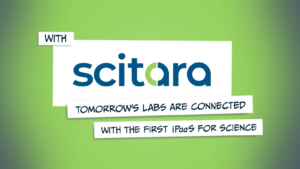The following is the second of a series of articles exploring the “Composable Architecture.” In the first article, we unpacked the term Composable Architecture and explored how it is relevant to laboratory IT. This article will explore how Scitara DLX can help extend your Composable Architecture into the laboratory.
In the previous article, we explored the concept of Composable Architecture in the context of laboratory IT. Composable Architecture leverages the business interfaces and authentication mechanisms exposed by most modern cloud-based applications to allow applications to be “composed” using low/no-code tools found in most integration platform-as-a-service (iPaaS) systems. In most verticals of a typical enterprise, work inputs and products are well-handled by many business-agnostic iPaaS solutions, but this is not the case in the laboratory, where the work inputs and products are often sample lists, plate maps, chromatographic results, pH measurements, or streaming bioreactor data.
In this article, we will dive deeper into Scitara DLX, the first iPaaS for science, which extends modern connectivity and standardized interfaces required by a Composable Architecture into the laboratory.
Scitara DLX has a unique connectivity strategy that addresses the diversity of technologies that exist in the lab. Scitara DLX employs an industry-standard technology called Kubernetes for microservice instance management. The message queue is used by these services to communicate. As soon as any of these services start, they plug into the message queue and begin processing and publishing events relevant to the service they provide. This “stateless” quality means that if one particular service is unable to process the frequency of messages for its service, the cluster supervisor will spin up another instance of the service to distribute the load. A typical DLX cluster will be constantly changing, with service instances spinning up and shutting down to accommodate usage loads.
While we won’t go into significant depth into the security aspects of DLX here, in brief, all these services run inside an isolated virtual network. Egress into/out of this network is controlled by a firewall and egress controller which restricts traffic into the network and directs it to the correct service.
To connect on-prem laboratory assets, the RCS (Remote Connection Service) is used. DLX provides mechanisms to communicate with lab resources and allow them to securely connect into the RCS. Once connected to the RCS, lab resources can publish or subscribe to DLX events through an encrypted channel.
To better understand how the Composable Architecture works, let’s consider a simple example. Imagine a lab that uses a cloud based ELN and wants to create an application that allows a user to submit a list of samples to a chromatography system and retrieve the results back into the ELN. Before the advent of Composable Architecture, such a workflow would have required each ELN or LIMS system to have an integration for all lab equipment, or alternatively, the ELN or LIMS would have needed to allow a generic import or export of a CSV file for transferring sample lists and results.
However, with DLX, we can easily compose this application. The ELN and chromatography connections into DLX normalize the data and instructions exchanged between each, allowing the orchestration designer to map or refer to data from each connection to compose instructions for the next connection.
Today, DLX is rapidly evolving, and is primarily used by IT professionals seeking to modernize their laboratory IT infrastructure and provide the same level of connectivity, automation, and adaptability enjoyed by other enterprise verticals. Scitara DLX, as a true iPaaS, comes with an intuitive and user-friendly low/no-code orchestration designer that enables IT professionals to create standardized workflows. Additionally, we are seeing scientists and lab workers use DLX to automate tasks. In the third and final article of this series on the Composable Architecture, we will explore how Scitara DLX has been used to improve upstream bioprocess development.
